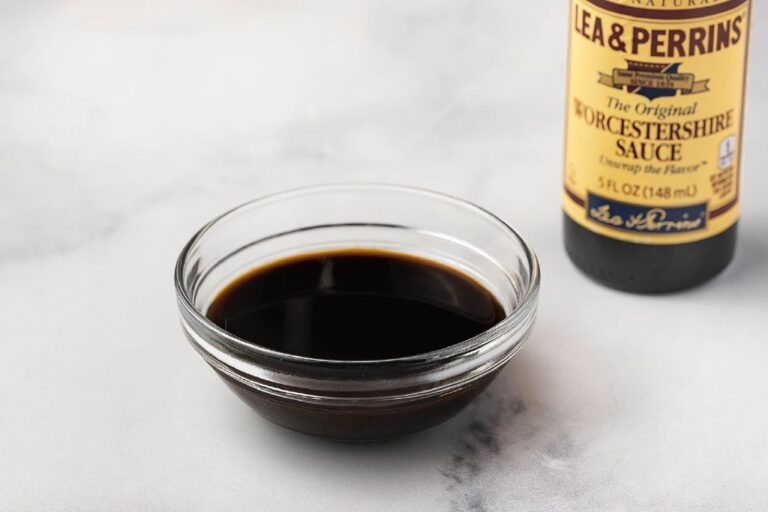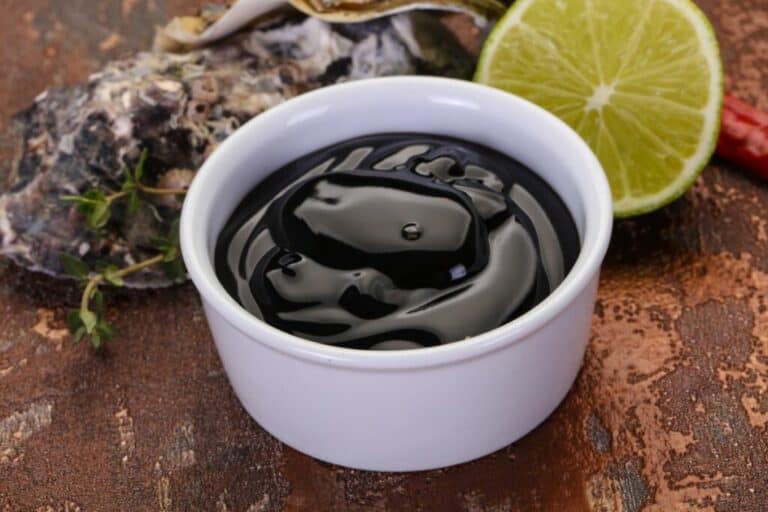Fish Sauce Substitute for Kimchi: Alternative Flavorful Condiment

Are you a fan of kimchi, the tantalizing Korean dish that packs a punch of flavors? If so, you’re probably familiar with the secret ingredient that gives kimchi its distinct taste: fish sauce. But what if you follow a vegetarian or vegan diet or simply prefer to avoid fish products?
Fear not, for we have the solution! In this article, we’ll dive into the world of fish sauce substitutes for kimchi. We will introduce you to a range of alternative and flavorful condiments that can take your homemade kimchi to new heights.
From soy sauce and tamari to mushroom sauce and anchovy-free fish sauce, we’ll explore umami-rich options to enhance your kimchi’s flavor.
Join us on this mouthwatering journey to find the perfect fish sauce substitute for your beloved kimchi. Get ready to unlock a world of alternative flavors that will elevate your culinary creations!
Fish Sauce and Kimchi

Fish sauce and kimchi, two iconic staples of Asian cuisine, share a remarkable bond that transcends borders and tantalizes taste buds. Fish sauce, from Southeast Asia, and kimchi, from Korea, have distinct flavors that add depth and complexity to dishes.
This intriguing connection between the umami-rich fish sauce and the tangy, spicy kimchi creates a dynamic interplay of tastes that takes culinary exploration to new heights.
Fish sauce, crafted from fermented fish and salt, lends a savory umami punch to dishes. Its bold flavors are known for harmonizing with various ingredients, enhancing the taste profile of dishes like no other.
Similarly, kimchi, made through the fermentation of vegetables, most commonly cabbage, with chili, garlic, and other seasonings, boasts a tangy, spicy kick that is uniquely its own. The marriage of these two powerhouses of flavor opens up a world of culinary possibilities.
When fish sauce and kimchi unite in a dish, an explosion of taste and aroma occurs. The umami notes from the fish sauce seamlessly blend with the tangy, spicy flavors of kimchi, creating a symphony of tastes that dance on the palate.
Whether it’s a stir-fry, a soup, or even a simple rice bowl, the combination of fish sauce and kimchi elevates the dish to a whole new level of deliciousness.
The fermented nature of both fish sauce and kimchi also contributes to their health benefits. Fermented foods are known to be rich in probiotics, which promote a healthy gut and aid in digestion. Additionally, these foods often contain beneficial enzymes and nutrients that can boost overall well-being.
Dietary Restrictions and Fish Sauce
Dietary restrictions can pose a significant challenge when it comes to incorporating fish sauce into meals. For vegetarians and vegans, the traditional fish-based condiment is off-limits due to its animal-derived nature. Likewise, individuals with seafood allergies must avoid fish sauce to prevent adverse reactions.
However, the good news is that there are viable alternatives that can replicate the distinctive flavors of fish sauce while catering to specific dietary needs.
Traditional Substitutes for Fish Sauce in Kimchi
When it comes to replacing fish sauce in kimchi, traditional substitutes like soy sauce and miso paste step in as reliable alternatives. These substitutes provide a rich, savory flavor and can be used in varying quantities to achieve the desired taste. Table 1 provides an overview of traditional substitutes for fish sauce in kimchi.
Table 1: Traditional Substitutes for Fish Sauce in Kimchi
| Substitute | Flavor Profile | Usage in Kimchi |
| Soy Sauce | Salty, savory, and slightly sweet | Use in moderation to avoid overpowering taste |
| Miso Paste | Earthy, savory, and slightly sweet | Adds depth to kimchi; adjust quantity to taste |
Exploring Vegan/Vegetarian Fish Sauce Alternatives
Vegans and vegetarians need not despair when it comes to finding alternatives to fish sauce. With the rise in plant-based eating, numerous options have emerged that capture the essence of fish sauce without using any animal products.
Seaweed-based sauces, for instance, harness the natural umami flavors present in seaweed to create a vegan-friendly substitute. The subtle oceanic notes of seaweed can add depth and complexity to various dishes, including those that traditionally call for fish sauce.
Another fantastic option for vegan and vegetarian fish sauce substitutes is mushroom-based sauces. These sauces utilize the rich, earthy flavors of mushrooms to mimic the umami taste of fish sauce. Mushroom-based alternatives can deliver a savory punch, enhancing the taste of stir-fries, noodle dishes, and even dipping sauces.
One particular culinary realm where vegan/vegetarian fish sauce alternatives shine is in kimchi recipes. Kimchi, a Korean fermented dish, typically incorporates fish sauce for its distinct flavor. However, using plant-based alternatives allows individuals with dietary restrictions to enjoy this tangy, spicy delicacy. Seaweed-based or mushroom-based sauces can be used to infuse the fermented cabbage with umami goodness, ensuring that even vegan or vegetarian versions of kimchi burst with flavor.
It’s worth noting that while vegan/vegetarian fish sauce alternatives can provide similar taste profiles, each option may have its own unique characteristics. Experimentation is key to finding the substitute that best suits individual preferences and desired flavors.
Whether it’s exploring seaweed-based sauces, mushroom-based sauces, or other creative plant-based condiments, vegan and vegetarian eaters have a range of choices to enjoy umami-rich dishes without compromising their dietary principles.
Exploring Non-Traditional Substitutes for Fish Sauce
When it comes to substituting fish sauce in kimchi, exploring non-traditional condiments opens up a world of exciting possibilities.
One unconventional option is fermented bean paste, which can bring a robust and earthy flavor to your kimchi. This paste, derived from fermented soybeans, adds depth and complexity to the dish, infusing it with its unique umami essence. Incorporating fermented bean paste into your kimchi recipe can provide a distinct twist that sets your creation apart.
Another non-traditional substitute for fish sauce in kimchi is Worcestershire sauce. While Worcestershire sauce is not typically associated with Asian cuisine, its tangy and savory nature can add an unexpected kick to your kimchi. The blend of vinegar, molasses, and various spices in Worcestershire sauce can contribute a delightful complexity of flavors, enhancing the overall taste of your kimchi.
These non-conventional alternatives allow for creative experimentation, introducing new dimensions to the traditional kimchi experience. You can give your kimchi a unique flavor by using fermented bean paste or Worcestershire sauce.
It’s important to note that while non-traditional substitutes can offer intriguing flavor profiles, they may also alter the overall taste of the kimchi compared to using fish sauce. The key is to explore and find the combination of ingredients that aligns with your taste preferences and culinary vision. Embrace the opportunity to think creatively and let your taste buds guide you as you craft a kimchi that showcases your personal style.
Homemade Fish Sauce Substitutes
If you enjoy the art of culinary experimentation and prefer a hands-on approach, creating your own homemade fish sauce substitute is an exciting option to consider.
By making it from scratch, you have the freedom to customize the ingredients and adjust the flavors to suit your preferences. Crafting your own fish sauce substitute allows for a more personalized and tailored experience, ensuring that it harmonizes flawlessly with your kimchi.
A common base for homemade fish sauce substitutes is soy sauce. Its rich and salty profile provides a solid foundation for creating a savory substitute. Soy sauce can mimic fish sauce’s complexity and depth when mixed with garlic, ginger, and spices. By adjusting the quantities of these components, you can fine-tune the taste to your liking, adding a personal touch to your kimchi recipe.
As with any culinary endeavor, the key to success lies in finding the right balance of ingredients and flavors. It may require some trial and error to achieve the desired result, but the process can be both rewarding and educational. By taking control of the ingredients and infusing your homemade fish sauce substitute with your own culinary flair, you can create a kimchi that reflects your unique taste and style.
Store-Bought Fish Sauce Alternatives
For those who prefer a convenient solution or don’t have the time to make their own fish sauce substitute, there is a wide array of store-bought alternatives available. Specifically designed for kimchi, these commercially produced substitutes offer a range of flavors and ingredients to cater to different taste preferences.
When choosing a good fish sauce product, it’s essential to consider the flavor profile you desire for your kimchi. Some substitutes may lean towards a more intense and robust taste, while others may offer a milder and subtler flavor. Reading product descriptions and reviews can provide valuable insights into the overall flavor experience.
Additionally, examining the ingredient list is crucial to ensuring that the substitute aligns with any dietary considerations or restrictions. Some store-bought alternatives may be vegan or vegetarian-friendly, while others may contain specific allergens or additives. Taking the time to understand the ingredients will help you make an informed decision and select a substitute that suits your needs.
Furthermore, it can be beneficial to experiment with different store-bought fish sauce substitutes to find the one that best compliments your kimchi recipe. Each product may have its own unique combination of flavors, which can add a distinct touch to your culinary creation.
The convenience and accessibility of store-bought fish sauce alternatives make them a practical choice for those who value time-efficiency or prefer the ease of ready-made options. By exploring the diverse range of options available, you can find a store-bought substitute that enhances the flavor of your kimchi and meets your specific requirements.
Adjusting Kimchi Recipes with Fish Sauce Substitutes
When substituting fish sauce in your kimchi recipe, it’s important to make appropriate adjustments to achieve a well-balanced flavor. While fish sauce contributes a unique taste to kimchi, using alternatives should not drastically change the overall character of the dish. Here are some tips to help you modify your kimchi recipe when using fish sauce substitutes:
- Start with small quantities: Begin by adding a smaller amount of the substitute and gradually increasing it as needed. This approach allows you to gauge the impact on the flavor without overpowering the dish.
- Taste and adjust: Regularly taste your kimchi as you incorporate the substitute. This way, you can make necessary adjustments by adding more or adjusting other ingredients to achieve the desired flavor balance.
- Experiment with combinations: Feel free to combine different substitutes to create unique flavor profiles. For example, you could mix soy sauce with a touch of Worcestershire sauce or add a dash of fermented bean paste along with miso paste. Be creative and find the combination that suits your palate.
- Consider fermentation: Keep in mind that the flavors of kimchi continue to develop during the fermentation process. The substitute you choose may mellow or intensify over time, so take this into account when adjusting the quantity.
By following these guidelines, you can ensure that your kimchi maintains its authentic taste and delivers a satisfying culinary experience, even without traditional fish sauce.
Conclusion
To summarize, there are various flavorful condiments that can be used as substitutes for fish sauce in kimchi. Soy sauce, tamari, mushroom sauce, anchovy-free fish sauce, seaweed-based seasonings, vegetable broth, fermented soybean paste, apple cider vinegar, and brine from pickled vegetables all offer unique flavors that can enhance the taste of your homemade kimchi.
Don’t be afraid to experiment and find the perfect combination of substitutes that suits your dietary preferences and creates a delightful culinary experience. Enjoy the process of exploring these alternatives and let your creativity shine in the world of kimchi-making!
FAQs about fish sauce substitutes for kimchi
Can I omit fish sauce altogether when making kimchi?
While fish sauce contributes to the unique flavor of kimchi, you can still make delicious kimchi without it. Experiment with suitable substitutes to maintain a flavorful profile.
Will using a fish sauce substitute drastically change the flavor of kimchi?
The flavor may vary slightly when using substitutes, but with careful adjustments and experimentation, you can achieve a comparable taste that satisfies your preferences.
Are there any health benefits associated with fish sauce substitutes?
Fish sauce substitutes can provide alternative nutritional benefits, such as lower sodium content or plant-based ingredients, depending on the substitute chosen.
How can I ensure that my kimchi maintains its authentic taste without fish sauce?
Pay attention to other traditional kimchi ingredients like gochugaru (Korean red pepper flakes), garlic, ginger, and vegetables. These components, combined with a suitable substitute, can help maintain the essence of kimchi.
Can I use fish sauce substitutes interchangeably in other recipes?
Yes, fish sauce substitutes can be used in various recipes that call for fish sauce to add umami flavor. Experiment and adjust quantities based on the specific dish and your personal taste preferences.
Are there any specific substitutes recommended for individuals with soy allergies?
Yes, for those with soy allergies, seaweed-based alternatives or homemade substitutes using ingredients like dried mushrooms can provide flavorful options without soy.
Where can I find store-bought fish sauce substitutes for kimchi?
Look for good fish sauce substitutes in well-stocked grocery stores, Asian markets, or online retailers. Check the condiment section or inquire with the store staff for specific recommendations.






